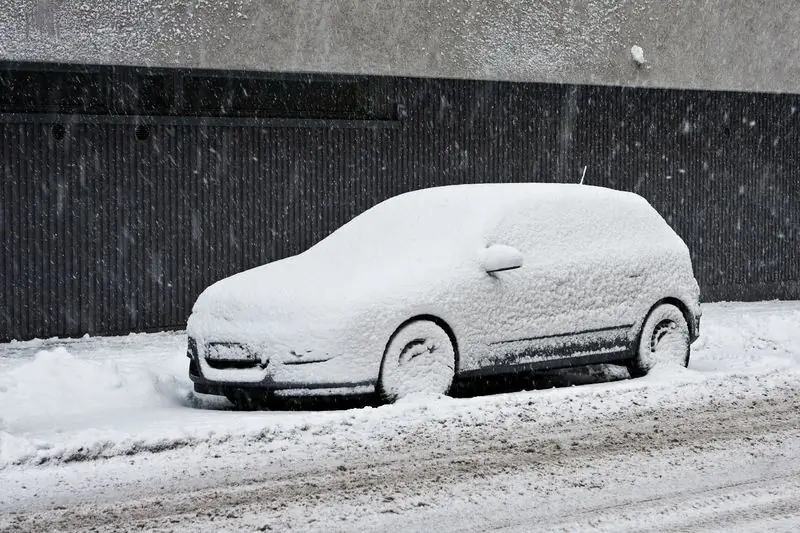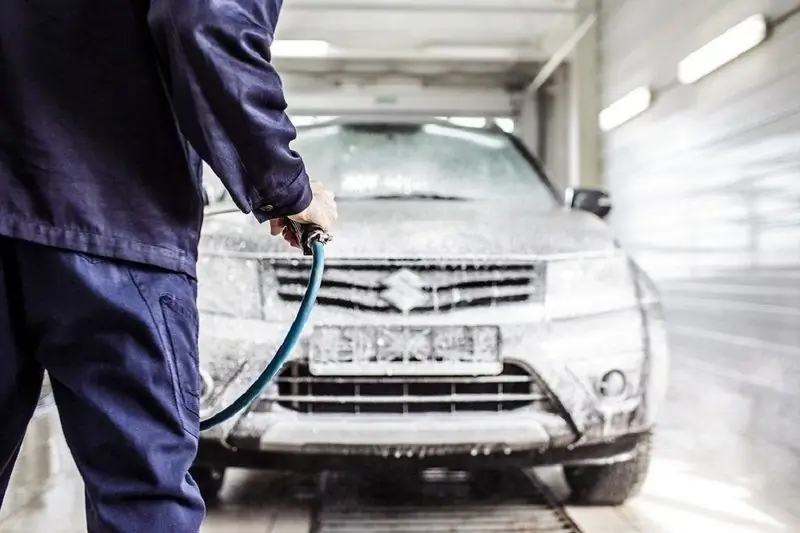
Table of contents:
- Author Bailey Albertson [email protected].
- Public 2023-12-17 12:53.
- Last modified 2025-01-23 12:41.
What to do if the windscreen washer fluid has frozen in the tank

In order for the windshield washer fluid to cease to perform its functions, the driver does not have to wait for thirty-degree frosts. Sometimes for this you just need to purchase a low-quality "anti-freeze". And now a person is forced to stop every ten minutes and manually wipe the dirty windshield. Can this situation be avoided? Of course! Let's figure out how to do it.
Causes of freezing windshield washer fluid
There are several reasons why windscreen washer fluid can freeze in the tank of a car, even at relatively low temperatures:
-
"Anti-freeze" is of high quality, but it is made on the basis of ethyl alcohol. Since 2006, in our country, they officially stopped selling washing fluids based on ethyl alcohol, replacing it with isopropyl alcohol. The fact is that isopropyl alcohol is less volatile. However, it is more expensive, therefore, "non-freezing" made on its basis is also expensive. Drivers looking to save money buy cheap ethanol-based washer fluid with denaturing additives. The result is not long in coming: the alcohol gradually evaporates from the liquid and it begins to freeze right in the nozzles;

Pouring cheap anti-freeze It is strongly discouraged to use a cheap "non-freeze" without labels on the canister
- buying counterfeit. Unscrupulous sellers often dilute the washer fluid with plain tap water. The logic is simple: if you drain a little liquid from several bottles and replace it with water, you can get an extra bottle of anti-freeze. Such "sellers" usually do not care about the fact that the liquid ceases to fulfill its functions. Recently, this has become a real misfortune, especially in the central regions of our country. Moreover, the price of the liquid does not play any role: both expensive "non-freezing" and cheap ones can be diluted.
What to do if the washer fluid is frozen in the reservoir
Consider typical situations with frozen washer fluid and options for action in these situations.
Freezing of liquid in nozzles
The option with freezing of liquid in nozzles is the most common. If the washers suddenly stopped working, this does not mean that the entire reservoir of fluid is frozen. This usually means that ice has accumulated in the hoses and in the washer nozzle channels.

Typical windshield washing scheme on a passenger car
This is due to the use of an ethyl alcohol based fluid. If the driver has used up half of the anti-freeze tank, the ethyl alcohol contained in the remaining half begins to evaporate rapidly. It fills the empty space in the tank, and then the vapors leave the washer system through hoses and nozzles. Gradually, only denaturing additives and water remain in the tank. Once in cold nozzles, it all freezes very quickly. To quickly clean the nozzles, the driver will have to go to a regular pharmacy and purchase the following items:
- disposable syringe;
- alcohol-containing tincture. It can be a tincture of calendula or a tincture of hawthorn. You should take 3-4 bubbles. It should be noted here that the pharmacist in the pharmacy may not sell these tinctures to the driver (recently this phenomenon has been observed everywhere, in connection with cases of mass poisoning with fake hawthorn tincture);
- if it was not possible to purchase the tincture at the pharmacy, you should visit the hardware store and purchase a bottle of denatured alcohol there.
It should also be noted here that as a means for defrosting nozzles, drivers often use special liquids designed to defrost door locks on cars. This is a good option. The only problem is that not every driver has such a liquid at hand. In addition, it is expensive, and recently it is not possible to find it everywhere.
Sequence of operations
The driver does not need to do anything super complicated.
-
The alcohol-containing liquid is drawn into the syringe, the needle is inserted into the nozzle and the liquid is gradually squeezed out into the flushing system. It takes about 10 minutes for the ice in the hoses and nozzles to completely melt (although this time directly depends on the temperature outside: in a thirty-degree frost, cleaning can take 20 minutes or more).

Flushing the washer nozzle The best tool for flushing a frozen nozzle is a regular syringe.
- If the liquid is partially frozen in the tank, then part of the alcohol should be poured into the tank as well. After that, you will have to wait a while until the alcohol dissolves the ice and the liquid becomes truly non-freezing.
Complete freezing of liquid in the tank
And if the tank is literally frozen under the neck, and there is no alcohol at hand (or the driver simply does not want to go shopping), then you can drive to the nearest car wash and ask the employee to fill the tank with water from a hose. In this case, the water may not be hot. Even cold water will wash away the ice over time. When the ice melts, you need to try to spray the resulting liquid on the windshield. If this works out, you must continue to spray on the glass until the liquid in the tank runs out. Thus, the nozzles and hoses are rinsed out, and new, high-quality liquid can be poured into the empty tank.

If the ice in the tank has completely melted, the liquid should be sprayed onto the glass
Video: how to warm up frozen windshield washer fluid
So, the car "non-freezing" can also freeze, no matter how paradoxical it may sound. Fortunately, even a novice driver can deal with this problem on their own. The main thing is to have the necessary liquid on hand and exactly follow the recommendations given in this article.
Recommended:
Cesspool And Septic Tank With Your Own Hands Without Pumping Out - Step By Step Instructions With Photos And Videos

The device and features of storage tanks for suburban sewer systems. Instructions for the arrangement and operation of a cesspool and septic tank without pumping
What Means And How To Dry-clean The Car Interior With Your Own Hands + Photos, Videos And Reviews

You can do it yourself dry cleaning of the car interior. You just need to know which means are suitable for this
Why It Is Impossible To Warm Up A Car Engine In Winter: Is It True Or A Myth, What Can Threaten, Is There Any Harm To The Car

Is it worth warming up a car engine in winter? What are the supporters of warming up guided by What the opponents stand for
Is It Possible And How To Wash A Car In Winter, Including At A Self-service Car Wash

Can I wash my car in winter, and if so, how often can I do it? How to properly wash a car in winter. Features of the procedure at a self-service car wash
How To Make A Septic Tank For A Private House With Your Own Hands - Step By Step Instructions With Photos, Drawings And Video

Design, principle of operation and features of installation and operation of septic tanks. DIY design and manufacture of concrete treatment facilities
